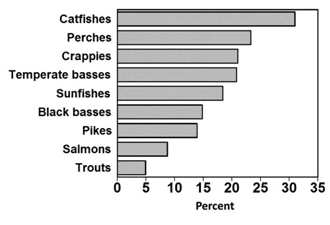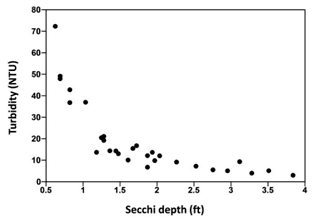Chapter 5 : Water Clarity
- 5.1 Introduction
- 5.2 Total Solids
- 5.3 Turbidity
- 5.4 Transparency
- 5.5 Sources of Suspended Solids
- 5.6 Longitudinal Gradients
- 5.7 Biotic Effects
- 5.8 Water Clarity Management
- 5.8.1 Monitoring Considerations
- 5.8.2 Shore Erosion Control
- 5.8.2.1 Vegetation protection
- 5.8.2.2 Offshore breakwaters
- 5.8.2.3 Rock-log structures
- 5.8.2.4 Floating breakwaters
- 5.8.2.5 Groynes
- 5.8.2.6 Rock vanes
- 5.8.2.7 Revetments
- 5.8.2.8 Natural stone revetment
- 5.8.2.9 Bulkheads and seawalls
- 5.8.2.10 Sills
- 5.8.2.11 Living shorelines
- 5.8.2.12 Tree felling
- 5.8.2.13 Boat traffic ordinances
- 5.8.3 Flocculation
- 5.8.4 Fishery Management
- 5.8.5 Aesthetics
5.1 Introduction
Water clarity refers to the transparency or clearness of the water and is influenced by turbidity and color. Turbidity is often used as a general term to describe the lack of transparency or the “cloudiness” of water resulting from the presence of suspended solids and colloidal materials such as clay, finely divided organic and inorganic matter, and plankton or other microscopic organisms (Davies-Colley and Smith 2001). Visibility through the water decreases as turbidity increases. The reduction in visibility is due to scattering of light by suspended particles (solids) in solution. Water clarity is influenced by water color. Pure water is transparent and colorless. Colored components in water absorb light energy, preventing it from penetrating as deeply as in colorless water and potentially altering temperature. The zone between the surface and the depth where light intensity is reduced to 1% of the intensity at the surface is defined as the photic zone. The rate at which light is attenuated in the water column is the light attenuation coefficient.
Solids that determine scattering of light and water clarity include inorganic and organic particulates, and suspended solids. Inorganic particulates are silt and sand that eventually settle to the bottom, resulting in sedimentation (section 3). The organic component may include dissolved organic matter and algae. Suspended solids are smaller particles that remain in suspension and generally account for most of the loss of water clarity. The sources of abiotic suspended solids include runoff from clear-cut or overgrazed watersheds, road or building construction, wave-induced sediment resuspension and shore erosion, and the bottom-stirring feeding activities of fish. There are other light-attenuating constituents of water besides suspended solids, most notably the water itself and its content of colored dissolved organic humic substances (Davies-Colley et al. 1993; Kirk 1994), but typically suspended solids are the dominant influence on light attenuation in natural waters.

Water clarity can be measured as concentration of suspended solids or indexed as turbidity or transparency (Davies-Colley and Smith 2001). Suspended solids measured as concentrations typically are measured in the laboratory. Conversely, turbidity and transparency measure optical qualities that can be measured on-site and more cheaply than solids in the laboratory. Both turbidity and transparency can be calibrated to solids with reasonable predictive accuracy, although calibrations are spatially and temporally specific as solids’ composition varies and affects relationships (Beschta 1980; Gippel 1995).
Water clarity is a major issue in reservoir fish habitat management, particularly in reservoirs of the central USA. A recent survey identified that the percentages of reservoirs considered impaired by turbidity vary regionally across the USA (Figure 5.1), with inorganic and organic turbidity distressing as many as 40% and 20% of reservoirs, respectively, in the temperate plains region (Krogman and Miranda 2016). The survey also identified the most important taxa in the recreational fisheries of these reservoirs. Catfishes, perches, crappies, and temperate basses provided the most common fisheries in reservoirs where inorganic turbidity was scored as moder- ate-to-high or high concern (Figure 5.2). Conversely, trout, salmon, pike, and black bass were less common in the fisheries of turbid reservoirs.
5.2 Total Solids
Total solids is a measure of the concentration of all solids in a water sample. They are measured by evaporating all of the water out of a sample at a standard tem- perature (103–105°C) and weighing all the solids that remain (APHA 1998). Total sol- ids can be classified into (1) suspended and dissolved solids, and (2) volatile and non-volatile solids.
Suspended solids are that portion of total solids caught by a 0.45-micron filter (APHA 1998), or other pore size depending on standard method. The solids that pass through the filter and remain after the filtered water is dried are the dissolved solids. Suspended solids can be partitioned further into volatile and nonvolatile suspended solids. Nonvolatile suspended solids are those that remain after the suspended solids are ignited at 550°-600°C, whereas volatile suspended solids are those ignited. Volatile suspended solids are considered organics and nonvolatile suspended solids considered inorganic (APHA 1998).

The particle size distribution is a key determinant of the effects of suspended solids on reservoir water clarity (Davies-Colley and Smith 2001). Particle size distribution controls not only the nature of the effects, by regulating the extent of water column turbidity and deposition rate, but also their spatial coverage. Fine particles stay in suspension for longer periods of time and for farther distances from their source, thus affecting considerably larger areas than coarse particles. Moreover, fine particles are more likely to become resuspended under windy conditions, particularly in shallow reservoirs or shallow embayments, and can adsorb more nutrients and other substances to their surfaces. The transport of clay particles in reservoirs is influenced greatly by wind-induced wave action and by influent tributaries. Effects of turbidity are, therefore, often manifested most strongly in the upper regions of a reservoir and in shallow embayments (Thornton 1990).
5.3 Turbidity
Turbidity is an optical property of the water and a general term that describes the cloudiness of water. It measures light scattering and absorption by suspended sediment, dissolved organic matter, plankton, and other microscopic organisms (APHA 1998). Consequently, turbidity is a key water-quality parameter in aquatic systems in that it has a major influence on the depth to which photosynthesis can occur and is therefore a critical determinant in the distribution of aquatic plants. Turbidity can be caused by many substances, including microscopic organisms (phytoplankton and zooplankton), bacteria, dissolved organic substances that stain water, suspended clay particles, and colloidal solids.
Although turbidity is easier to measure than suspended solids, there are limitations when using turbidity as a surrogate measure of suspended solids because the relationship between turbidity and suspended solids is confounded by variations in particle size, particle composition, and water color (Gippel 1995). Turbidity responds to factors other than just suspended solids concentrations: turbidity readings are influenced by the particle size and shape of suspended solids and the presence of phytoplankton, dissolved humic substances, and dissolved mineral substances. Consequently, a high turbidity reading can be recorded without necessarily involving a high suspended solids concentration or similar turbidity measurements from different locales may represent different concentrations of suspended solids. There is no universal relationship between turbidity and suspended solids. Site-specific relationships can be developed (e.g., Kunkle and Comer 1971; Beschta 1980; Gippel 1995), but even these relationships can vary from storm to storm, seasonally, and from year to year (Beschta 1980). When relying solely on turbidimeter data, it is not easy to know exactly what is causing the turbidity.
Turbidity traditionally has been measured as the absorption and scatter properties of light when it passes through water and reported in terms of two units of measure. The unit most frequently encountered in older reports is Jackson Turbidity Units (JTU), measured by a Jackson candle turbidimeter. The APHA (1998) no longer recommends the measurement of turbidity using this technique. More recently, turbidity is measured using a nephelometric turbidimeter that measures light scattering relative to a standard suspension, usually of formazin. Turbidity, as measured by this type of turbidimeter, is reported in Nephelometric Turbidity Units (NTU). The APHA (1998) currently recommends that NTU be used as the standard of measure for reporting turbidity.
Increased turbidity also can influence the heat budgets of reservoirs through the absorption of heat by suspended particles (Kirk 1985) or by increased reflection of sunlight back to the atmosphere (Clarke et al. 1985). Therefore, depending on the nature of the suspended sediment, mineral turbidity can cause water temperatures to increase or decrease. Alterations to heat budgets may, in turn, affect other abiotic processes indirectly. By modifying water temperature and therefore water density, temperature alters the settling velocity of suspended particles, especially those with densities close to that of water (Kerr 1995).
5.4 Transparency
Historically, water transparency has been measured in standing water bodies with a Secchi disk, a black-and-white disc that is lowered into the water by a graduated line until the image is judged to disappear from view. The depth of disappearance, the Secchi depth, is a useful index of visual water clarity. Secchi depth provides a simple and inexpensive indicator for the clarity of natural waters (Preisendorfer 1986). Secchi depth can vary depending on the reflectance of the white face of the disk and the reflectance of the water. Secchi depth readings are thus dependent on light conditions(Davies-Colley and Smith 2001). Standardization of observations can increase precision (Smith 2001). Standardization can be achieved by (1) keeping constant the size and design of disk; (2) consistently measuring just above disk disappearance, at disk disappearance, at disk reappearance, or the mean of the latter two; (3) collaborating between more than one observer to arrive at the numbers; and (4) measuring with the sun behind the person taking the measurement, except when the sun is directly overhead (Hambrook-Berkman and Canova 2007).

Secchi depth transparency is correlated with turbidity, but they measure different things (Effler 1988). These two measures differ in their sensitivity to the light attenuation processes (i.e., absorption and scattering), and therefore measurements are affected by different substances that determine attenuation. Secchi depth becomes increasingly more insensitive to changes in turbidity and scattering at high values of turbidity and even more insensitive to changes in absorption. Absorption becomes progressively more important in influencing Secchi depth at low turbidity. Because of these relationships, Secchi depth does not respond linearly to turbidity, and the relationship between NTU turbidity values and Secchi depth is curvilinear (Figure 5.3).
5.5 Sources of Suspended Solids
The weathering and decomposition of rocks, soils, and dead plant material and their transport into streams and reservoirs represent the natural background of solids washed from a watershed (Sorensen et al. 1977). However, rates of transport have been augmented by anthropogenic disturbances to landscapes surrounding reservoirs and their tributaries. In agricultural and grazing areas, removal of vegetation and compaction of soil can cause runoff to carry eroded topsoil into rivers. Fertilization practices also may increase loads of nutrients that result in turbid algal growths. In areas with forestry operations, timber-harvesting practices, road construction, slash disposal, and site preparation can increase inputs of solids. Overall, impervious surfaces created by urbanization prevent rain from penetrating into the soil, and causes water to run off more quickly and at greater velocities, resulting in the pick up and transport of materials into streams and reservoirs directly or in stormwater outfalls. Erosion of soils at construction sites without proper controls also can increase solids and cause associated reductions in water clarity. Mining operations expose soils and can result in chronic turbidity issues. Industrial effluents and storm water can directly input solids into streams.
Become a Contributing Sponsor
Become a part of projects that need your support.

